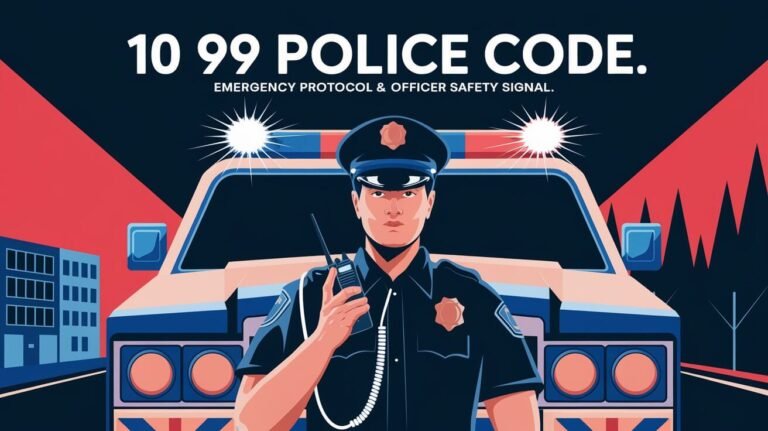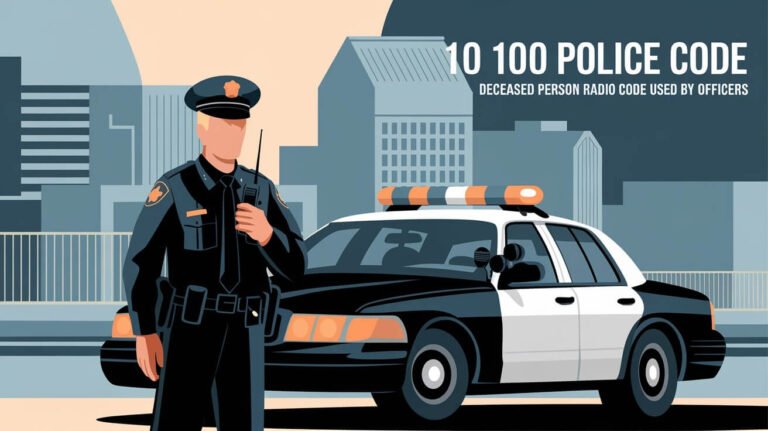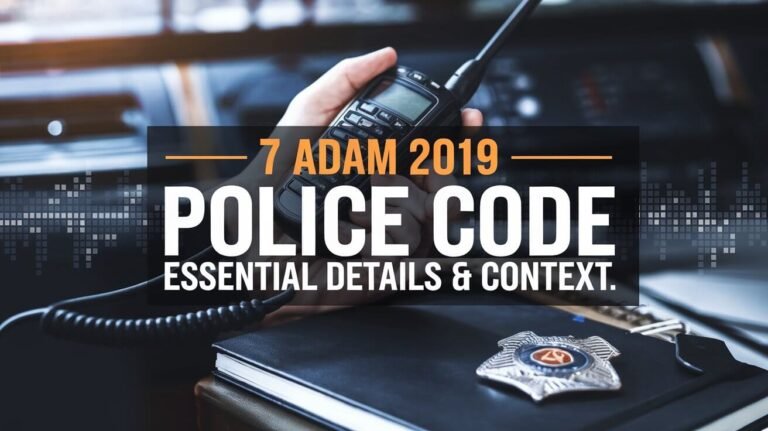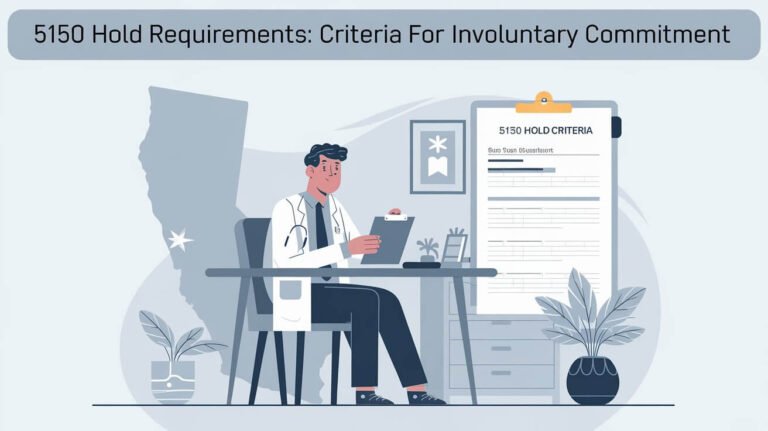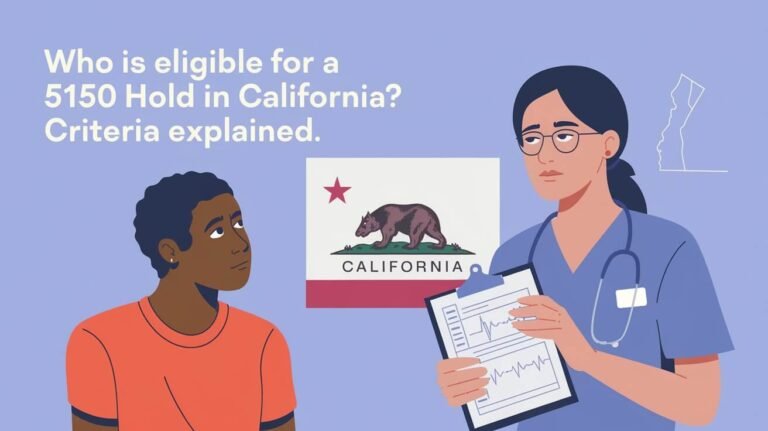1096 Police Code: Radio Signal for Mental Health Emergencies
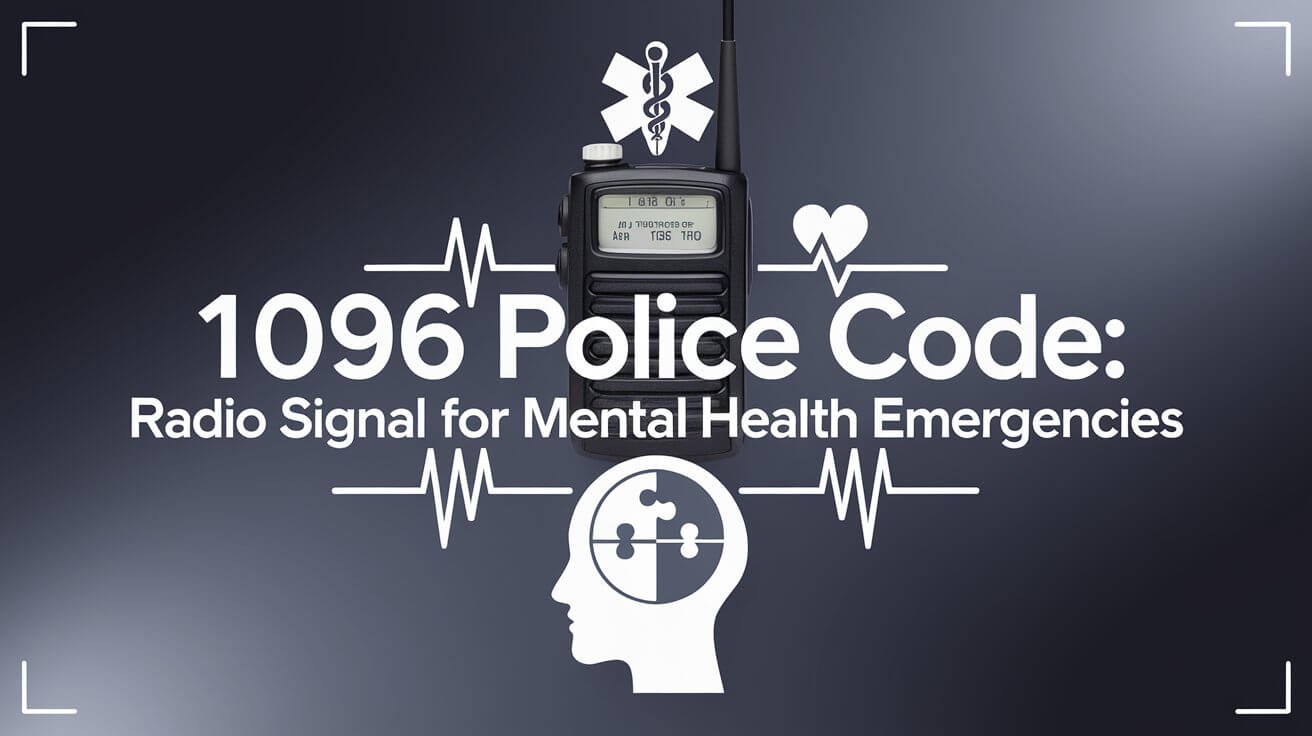
In law enforcement, clear communication is key. The 1096 police code is a vital part of this. It’s used by police across the country as part of a set of standardized radio codes. rephrase this
These codes, from 10-1 to 10-99, help police share important information quickly. They cover everything from signal strength to emergency alerts. This makes communication clear and universal.
The 1096 code is very important. It signals that there’s a mental patient or a suspect who needs special care. By using this code and others, police can share vital details fast. This helps them respond quickly and effectively to many situations.
Police Radio Codes Foundation and History
Police radio codes have been key in emergency response for many years. They started in the early 1900s. Law enforcement wanted to make officer-dispatcher talks clear and follow rules in urgent times.
Origins of Police Communication Systems
In the beginning, police used simple signals like bells and hand gestures. As technology got better, they moved to phones and radios. This led to the complex code systems we have today.
Evolution of Radio Code Standards
The 10-code system, with codes like 10-20 for location and 10-33 for emergencies, became common in the U.S. These codes have grown to handle more complex emergencies. Departments have updated their codes to fit their needs.
Implementation Across Departments
Some police forces use the same radio codes everywhere. But others have their own codes for their area. This means officers and dispatchers must learn the codes for their place.
1096 Police Code and Its Significance
The 1096 police code is special in dealing with mental health. It’s different from the usual 10-code system used by police. This code tells officers there might be a mental health issue.
When a 1096 code is sent out, it means there’s a mental patient or someone who needs to be detained for mental health reasons. This code is important because it calls for special ways of handling the situation.
Officers need to be ready to keep themselves and others safe. They must communicate well with dispatchers and respond quickly. This is because mental health crises need careful and informed handling.
It’s key for officers to get the right training for 1096 calls. They need to know how to calm the situation, help out, and make sure everyone is safe. The 1096 code is a big alert for police to take a special approach to mental health issues.
Core Components of Police Radio Communications
Effective police radio communications depend on a few key things. These include standard operating procedures, emergency response plans, and smooth communication between dispatchers and officers. Together, they help manage incidents quickly and efficiently.
Standard Operating Procedures
Police radios use clear, simple language and follow set codes. Officers are trained to share information well and fast. This helps avoid mistakes and keeps everyone on the same page.
Emergency Response Protocols
In emergencies, police radios get busy. Codes like “10-33” mean it’s a real emergency. This code calls for quick action from everyone involved.
Dispatcher-Officer Communication Flow
Dispatchers are the link between officers and the rest of the team. They pass on important info and help coordinate efforts. This makes sure everyone knows what to do and when.
| Code | Meaning |
|---|---|
| 1096 | Pedestrian stop |
| 1096X | Pedestrian stop, female |
| 1014 | Escort, most common at airport and occasionally special request |
| 1021 | Phone your office or home, officer to call citizen, officer to call another officer, officer to call family member |
Critical Emergency Codes and Their Meanings
Clear communication is crucial in law enforcement, especially during emergencies. Police radio codes help in quick responses and managing incidents. Some codes are critical for officer safety and emergency coordination.
The “10-33” code signals a general emergency, needing immediate help. It prompts a fast response from nearby officers and dispatch. The “10-32” code warns of a suspect with a gun, calling for extra caution.
The “10-78” code asks for urgent backup, showing the need for immediate help. These codes help officers communicate well in emergencies. They improve officer safety and incident management.
Other key codes include “10-50” for accidents, “10-55” for drunk drivers, and “10-80” for chases. Each code has a specific meaning. They help dispatch and officers quickly understand and manage the situation.
Learning these emergency codes is vital for law enforcement training. It ensures officers can communicate and respond well in various incident management situations.
Mental Health Response Protocols in Law Enforcement
Law enforcement faces unique challenges when dealing with mental health issues. Codes like 10-96 highlight the need for special crisis intervention methods. Agencies now focus on creating detailed mental health protocols. This ensures officer safety and offers the right support for those in need.
Crisis Intervention Techniques
Crisis intervention aims to calm down situations involving mental health issues. Officers learn to keep a safe distance and assess the situation carefully. They use calm words and non-threatening body language to manage the crisis.
Officer Safety Guidelines
Keeping officers safe is key in mental health responses. They are taught to approach with caution and stay alert. They also know when to ask for help or backup. This approach helps them support individuals in crisis effectively.
De-Escalation Procedures
De-escalation is vital in handling mental health incidents without force. Officers use active listening and empathy to calm the person. They aim for a peaceful outcome, focusing on the well-being of everyone involved.
| Statistic | Value |
|---|---|
| Individuals with mental illness treated in the US (2019) | 44.8% |
| Individuals with serious mental illness (SMI) who received treatment (2019) | 65.5% |
| Police shootings involving someone with mental illness (2015 review) | 23% |
| Decrease in hospitalizations, referrals, and bookings with CIT training (Louisville Metro Police Department) | $1 million |
| People with mental illness involved in police-related deaths (2018 review) | 25% |
| Time taken by law enforcement to handle a call involving a person with mental illness | 30 minutes to 6.5 hours |
Adopting detailed mental health protocols, law enforcement can improve safety for officers. They also enhance outcomes for those in crisis and build trust in the community. This is achieved through effective crisis intervention and de-escalation methods.
Radio Code Categories and Classifications
Radio codes have evolved to help officers and dispatchers share information quickly. These codes cover everything from officer status to incident types, making communication smooth.
At the heart of police radio use are officer status codes. These show if an officer is ready or busy. For example, “10-6” means they’re busy, while “10-8” means they’re ready to go.
Location and movement codes help track officers. “10-20” shows their location, and “10-76” shows they’re on their way. This helps dispatchers keep tabs on officers.
Incident codes are well-known in law enforcement. “10-31” means there’s a crime happening, and “10-50” means there’s an accident. These codes help everyone know what’s happening and how to respond.
There are also codes for administrative tasks, vehicle issues, and public service. This makes sure law enforcement can handle many situations effectively.
| Code | Meaning |
|---|---|
| 10-1 | Receiving poorly |
| 10-4 | Affirmative or agreement |
| 10-13 | Weather conditions or road information |
| 10-28 | Identifying one’s station |
| 10-33 | Emergency traffic indication |
| 10-40, 10-61, 10-93 | Indicate the speaker is not a trucker |
| 10-50 | Need to break a channel |
| 10-75 | Causing interference |
| 10-99 | Completion of a mission or task |
| 10-100 | Need to use the bathroom |
| 10-200 | Request for police assistance |
The radio code system is essential for law enforcement in the U.S. It helps them respond quickly and effectively to many situations. By understanding these codes, everyone can work together to keep communities safe.
Dispatch Center Operations and Code Implementation
The dispatch center is where experts coordinate emergency responses. They follow a clear plan to ensure smooth communication during crises.
Communication Chain of Command
Supervisors at the dispatch center guide the team. Dispatchers handle calls, assign codes, and share details with officers. This setup helps manage incidents well and follow rules.
Response Time Management
Dispatchers use codes like “10-39” for urgent calls. This ensures quick responses to emergencies. Following these codes helps manage time and provide help when it’s needed most.
Information Documentation Protocols
Keeping accurate records is vital. Dispatchers use codes like “10-75” for contacts and “10-82” for lodging. These protocols help manage incidents and follow department rules.
| Statistic | Value |
|---|---|
| Anticipated Hiring Salary Range for Police Dispatcher I | $4,300 – $4,500 per month |
| Full CSU Classification Salary Range for Police Dispatcher I | $3,505 – $6,294 per month |
| Paid holidays a year for eligible employees | 14 |
| Dispatchers employed by Fresno State Police Department | 7 |
| Sworn officers in Fresno State Police Department | 27 |
| Community Service Specialists in Fresno State Police Department | 16 |
| Administrative support staff in Fresno State Police Department | 5 |
| Preferred dispatching experience | 3 years within the last 10 years |
Dispatch centers are essential for dispatcher communication, incident management, and protocol compliance. They ensure clear communication, quick responses, and detailed records. This support is vital for officers and public safety.
Regional Variations in Police Codes
Police radio codes vary a lot between different places and departments. Some codes, like “10-4” (meaning “acknowledgment”), are known everywhere in the U.S. But, other codes might mean different things in different areas. Some police use simple words instead of codes, while others have many codes for their radios.
This difference in codes can be hard for officers who work in different places. For example, the Indiana State Police use “10-0” for a fatality and “10-99” for someone wanted. But, in other areas, codes might mean something else. The SAFE-T Mutual Aid Areas have their own way of talking, with Region A covering places like Jasper and Lake.
Also, each area has its own unit numbers. Lowell is 13, Lafayette is 14, and Sellersburg is 45. The ISP District County Assignments show which counties are in each district, like Lafayette (14) and Putnamville (53).
To make sure everyone can talk clearly, police need regular training and clear rules. Knowing the different codes helps officers respond better in emergencies. It also helps them work together smoothly, no matter where they are.
Modern Technology Integration with Radio Codes
In law enforcement, combining modern digital systems with traditional radio codes has changed the game. These updates aim to boost incident management, quick response, and officer safety. Digital dispatch tools and advanced software are key, helping law enforcement work better and faster.
Digital Communication Systems
Police departments in the U.S. are moving to digital systems that work with radio codes. These systems share data in real-time, track locations, and give quick access to important info. This mix of old and new tech has changed how emergencies are handled, making responses quicker and more coordinated.
Software Solutions for Code Management
Law enforcement is also using special software to manage radio codes. These tools have central databases that make it easy to find and document codes. This digital approach helps officers and dispatchers get the info they need fast, cutting down on response times.
Future Technological Developments
Experts say we’ll see more tech integration in law enforcement soon. They think AI could help with dispatch, making predictions and suggestions. Also, mobile devices might soon connect directly with coded communications, giving officers quick access to vital data.
These new tech steps show law enforcement’s dedication to progress while keeping communication effective. As the field keeps evolving, the blend of digital tech and radio codes will be key to better incident handling, quick responses, and officer safety.
Wrap-Up
The 1096 police code and other radio communication protocols are key in law enforcement. They help officers work together quickly and effectively. These codes have changed a lot over time, keeping up with new technology and needs.
The 1096 code is important for handling mental health issues. But it’s part of a bigger system of police radio codes. These codes help share information fast and safely. They are vital for keeping officers safe, managing resources, and helping the community.
Looking ahead, using new technologies and training officers well will be important. Working with mental health experts and the community will also help. By doing this, law enforcement can keep using radio codes to help our communities.

